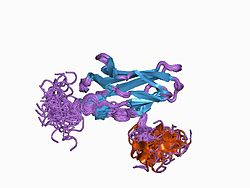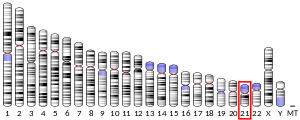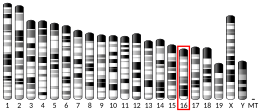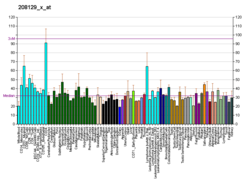RUNX1
Runx1(英:Runt-related transcription factor 1)はRUNX1遺伝子にコードされる転写因子である。ヒトでは21番染色体長腕上にある(21q22.12)。AML1(acute myeloid leukemia 1 protein)、CBFA2(core-binding factor subunit alpha-2)とも呼ばれる[5]。Runx1は、CBFβとヘテロ二量体を形成し、DNAと結合し転写を調節することで、造血系の分化において重要な役割を担っている[6]。
機能
[編集]Runx1は骨髄系・リンパ系に広く発現し[7]、転写因子としてIL-3、GM-CSF、ミエロペルオキシダーゼ、T細胞受容体、CSF-1Rなどの骨髄球・リンパ球の分化に関わる遺伝子のプロモーターを調節している[8][9]。
構造
[編集]Runx1はp53様転写因子(p53-like transcription factors)の1つで、ショウジョウバエで性分化や神経発生に関わっているRuntのホモログであり、DNAに結合する部分はRunt homologyドメイン(RHD)と呼ばれる。ヘテロ二量体を構成するCBFβはDNAに直接作用せず、Runx1と相互作用することで、アロステリックに調節している[10]。RunxのアイソフォームはRunx1のほかにRunx2とRunx3があるが、RHDに関しては90%以上の相同性があり、同じような仕組みでDNAに結合していると考えられている。Runx1が認識するDNA配列は(5') Py-G-Py-G-G-T-Py (3')(Pyにはピリミジン塩基すなわちCまたはTがくる)であるが、X線結晶構造解析により特にその配列の中のG(グアノシン)3つが重要であり、それぞれ3つアルギニン(R)を介してRunx1と相互作用していることがわかっている[10][11]。


疾患関連
[編集]
Runx1の異常は白血病に関わっており、t(8:21)の転座によって生じるFAB分類でM2の急性骨髄性白血病(AML)は有名である。この転座によって生じるキメラタンパク質AML1-ETO(AML1-MTG8, Runx1-Runx1T1)は、主としてCBFβと非機能性複合体を形成することで、CBFβが枯渇するために正常型のコア結合因子の機能不全を起こし、造血系が分化障害を起こして白血病に至ると考えられている。ただし、AML1-ETOは、通常コア結合因子(CBF)が転写調節に関わらないp21やBCL-2の活性化に関わっており、これらが白血病化に貢献している可能性がある[12]。
Runx1の標的遺伝子にSNPがあることで疾患につながることもある。例えば、リンパ球の自己寛容に関わる遺伝子のPDCD1(programmed cell death 1)の4番目のイントロンにあるRunx結合部位に変異(TGCGGTC→TGCAGTC)があると自己寛容に破綻を生じSLEを起こすことが知られている[13]。
出典
[編集]- ^ a b c GRCh38: Ensembl release 89: ENSG00000159216 - Ensembl, May 2017
- ^ a b c GRCm38: Ensembl release 89: ENSMUSG00000022952 - Ensembl, May 2017
- ^ Human PubMed Reference:
- ^ Mouse PubMed Reference:
- ^ Avramopoulos, D.; Cox, T.; Blaschak, J. E.; Chakravarti, A.; Antonarakis, S. E. (October 1992). “Linkage mapping of the AML1 gene on human chromosome 21 using a DNA polymorphism in the 3' untranslated region”. Genomics 14 (2): 506–507. ISSN 0888-7543. PMID 1427868.
- ^ Okuda, T.; Nishimura, M.; Nakao, M.; Fujita, Y. (October 2001). “RUNX1/AML1: a central player in hematopoiesis”. International Journal of Hematology 74 (3): 252–257. ISSN 0925-5710. PMID 11721959.
- ^ Robert B. Lorsbach, Jennifer Moore, Sonny O. Ang, Weili Sun, Noel Lenny, and James R. Downing (2003). “Role of RUNX1 in adult hematopoiesis: analysis of RUNX1-IRES-GFP knock-in mice reveals differential lineage expression”. Blood 103 (7). doi:10.1182/blood-2003-07-2439. PMID 14630789.
- ^ Speck NA, Stacy T, Wang Q, North T, Gu TL, Miller J, Binder M, Marín-Padilla M (1999). “Core-binding factor: a central player in hematopoiesis and leukemia.”. Cancer Research 59. PMID 10197598.
- ^ B Lutterbach, S.W Hiebert (2000). “Role of the transcription factor AML-1 in acute leukemia and hematopoietic differentiation.”. Gene 245 (2). doi:10.1016/S0378-1119(00)00014-7. PMID 10717473.
- ^ a b Tahir H. Tahirov, Taiko Inoue-Bungo, Hisayuki Morii et al (2001). “Structural analyses of DNA recognition by the AML1/Runx-1 Runt domain and its allosteric control by CBFbeta.”. Cell 104 (5). doi:10.1016/S0092-8674(01)00271-9. PMID 11257229.
- ^ Jerónimo Bravo, Zhe Li, Nancy A. Speck & Alan J. Warren (2001). “The leukemia-associated AML1 (Runx1)--CBF beta complex functions as a DNA-induced molecular clamp.”. Nature Structure Biology 8 (371). doi:10.1038/86264. PMID 11276260.
- ^ R. Katherine Hyde and P. Paul Liu (2010). “RUNX1 Repression Independent Mechanisms of Leukemogenesis by Fusion Genes CBFB-MYH11 and AML1-ETO (RUNX1-RUNX1T1)”. Journal of Cellular Biochemistry 110 (5): 1039-1045. doi:10.1002/jcb.22596. PMID 20589720.
- ^ Ludmila Prokunina et al (2002). “A regulatory polymorphism in PDCD1 is associated with susceptibility to systemic lupus erythematosus in humans”. Nature Genetics 32 (4): 666-669. doi:10.1038/ng1020. PMID 12402038.
外部リンク
[編集]- RUNX1 protein, human - MeSH・アメリカ国立医学図書館・生命科学用語シソーラス







